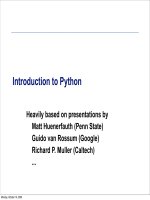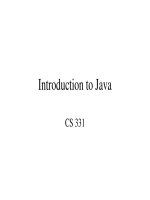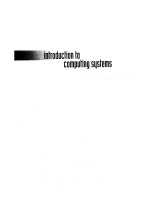Introduction to Computing: Lecture 6 - Dr. Pham Tran Vu
Bạn đang xem bản rút gọn của tài liệu. Xem và tải ngay bản đầy đủ của tài liệu tại đây (7.57 MB, 27 trang )
Introduction to Computing
Lectured by: Dr. Pham Tran Vu
Databases
The Hierarchy of Data
Keys and Attributes
The Traditional Approach To Data
Management
Database
“A collection of data, generally related to
some subject or topic area and structured so
as to allow relationships to be established
between separate data items according to
the various needs of users”
G. Knott & N. Waites, Computing 3rd edition
Database Approach
Traditional Files vs. Databases:
Pros and Cons
Traditional File Advantages
Simplicity
Efficiency
Customization
Database Advantages
Reduced data redundancy
Application/data independence
Better control
Flexibility
Disadvantages of Database
High Cost
Need specialized staff
Increase vulnerability
Database Management Systems
(DBMS)
Databases are usually managed by DBMS
DBMS: A collection of programs that controls and
prevents accidental or deliberate corruption of data
by other application programs
Functions of DBMS
Store, query and update data
Manage transaction
Control concurrent access to database
Maintain data consistency and integrity
Types of Databases
Hierarchical (tree)
Network
Relational
Hierarchical Database Model
Network Database Model
Relational Database Model
Relational Models
Describe data using a standard tabular format
with all data elements placed in twodimensional tables, called relations, that are
the logical equivalent of files.
Domain
Selecting
Projecting
Joining
Linking Database Tables to Answer
an Inquiry
Keys
Smallest set of attributes can be used to identify a
row in a table
Single key: composed of only one attribute
Composite key: composed of two or more
attributes
A table can have many keys
Primary key: a selected key
Candidate keys: other keys, except primary key
Foreign Keys
If a table uses the primary key of another
table as attribute to refer to a row in the
other table, the attribute is called referential
key or foreign key.
Primary and Foreign Keys
Primary Key
Foreign Key (implements 1:N
relationship between customer and
order)
Combined, these are a composite
primary key (uniquely identifies the
order line)…individually they are
foreign keys (implement M:N
relationship between order and
product)
Database Design and Construction
Data Modelling
To analyse and model the logical structures
and relationships between data items
To assist the data design process
Entity Relationship Model is commonly used
as a data modelling tool
Entity-Relationship Diagram for a
Customer Ordering Database
Entity Relationship Model
Entities
Objects of interest or relevant to the organisation, eg.
Customer, stock
Attributes
Properties of an entity which are identified as of interest
Relationships
The relationship between entities
Relationship types:
One-to-one
One-to-many
Many-to-many
Database Design
Convert entity relationship model to
relational model
Convert entities into tables
Identify keys and attributes
Create referential keys (foreign keys) for
relationships
Decide data types and length for attributes
Data Normalisation
A step-by-step process for analysing data
into its constituent entities and attributes
To improve database efficiency and to
maintain data consistency and integrity
Commonly, three normal forms are used:
First normal form (1NF)
Second normal form (2NF)
Third normal form (3NF)
Database Construction
Use tools, eg. MS Access
Use Structured Query Language (SQL)
Data Definition Language
for defining database and database tables
Commands: create database, create table, alter table,
drop table, etc.
Data Manipulation Language
For manipulating the data within data
Commands: select, insert, update and delete









